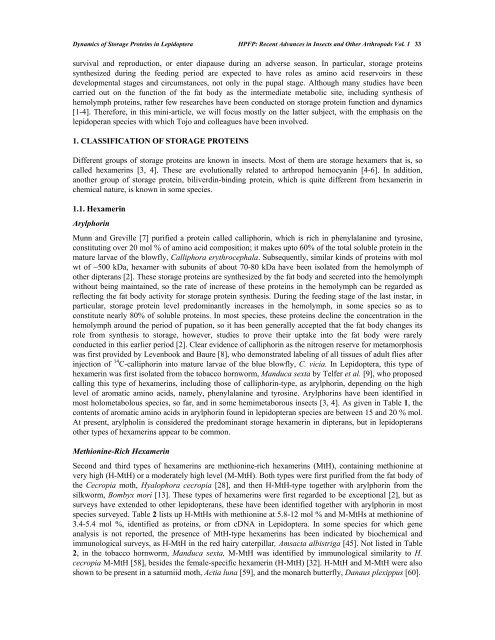chapter 1 - Bentham Science
chapter 1 - Bentham Science
chapter 1 - Bentham Science
You also want an ePaper? Increase the reach of your titles
YUMPU automatically turns print PDFs into web optimized ePapers that Google loves.
Dynamics of Storage Proteins in Lepidoptera HPFP: Recent Advances in Insects and Other Arthropods Vol. 1 33<br />
survival and reproduction, or enter diapause during an adverse season. In particular, storage proteins<br />
synthesized during the feeding period are expected to have roles as amino acid reservoirs in these<br />
developmental stages and circumstances, not only in the pupal stage. Although many studies have been<br />
carried out on the function of the fat body as the intermediate metabolic site, including synthesis of<br />
hemolymph proteins, rather few researches have been conducted on storage protein function and dynamics<br />
[1-4]. Therefore, in this mini-article, we will focus mostly on the latter subject, with the emphasis on the<br />
lepidoperan species with which Tojo and colleagues have been involved.<br />
1. CLASSIFICATION OF STORAGE PROTEINS<br />
Different groups of storage proteins are known in insects. Most of them are storage hexamers that is, so<br />
called hexamerins [3, 4]. These are evolutionally related to arthropod hemocyanin [4-6]. In addition,<br />
another group of storage protein, biliverdin-binding protein, which is quite different from hexamerin in<br />
chemical nature, is known in some species.<br />
1.1. Hexamerin<br />
Arylphorin<br />
Munn and Greville [7] purified a protein called calliphorin, which is rich in phenylalanine and tyrosine,<br />
constituting over 20 mol % of amino acid composition; it makes upto 60% of the total soluble protein in the<br />
mature larvae of the blowfly, Calliphora erythrocephala. Subsequently, similar kinds of proteins with mol<br />
wt of ~500 kDa, hexamer with subunits of about 70-80 kDa have been isolated from the hemolymph of<br />
other dipterans [2]. These storage proteins are synthesized by the fat body and secreted into the hemolymph<br />
without being maintained, so the rate of increase of these proteins in the hemolymph can be regarded as<br />
reflecting the fat body activity for storage protein synthesis. During the feeding stage of the last instar, in<br />
particular, storage protein level predominantly increases in the hemolymph, in some species so as to<br />
constitute nearly 80% of soluble proteins. In most species, these proteins decline the concentration in the<br />
hemolymph around the period of pupation, so it has been generally accepted that the fat body changes its<br />
role from synthesis to storage, however, studies to prove their uptake into the fat body were rarely<br />
conducted in this earlier period [2]. Clear evidence of calliphorin as the nitrogen reserve for metamorphosis<br />
was first provided by Levenbook and Baure [8], who demonstrated labeling of all tissues of adult flies after<br />
injection of 14 C-calliphorin into mature larvae of the blue blowfly, C. vicia. In Lepidoptera, this type of<br />
hexamerin was first isolated from the tobacco hornworm, Manduca sexta by Telfer et al. [9], who proposed<br />
calling this type of hexamerins, including those of calliphorin-type, as arylphorin, depending on the high<br />
level of aromatic amino acids, namely, phenylalanine and tyrosine. Arylphorins have been identified in<br />
most holometabolous species, so far, and in some hemimetaborous insects [3, 4]. As given in Table 1, the<br />
contents of aromatic amino acids in arylphorin found in lepidopteran species are between 15 and 20 % mol.<br />
At present, arylpholin is considered the predominant storage hexamerin in dipterans, but in lepidopterans<br />
other types of hexamerins appear to be common.<br />
Methionine-Rich Hexamerin<br />
Second and third types of hexamerins are methionine-rich hexamerins (MtH), containing methionine at<br />
very high (H-MtH) or a moderately high level (M-MtH). Both types were first purified from the fat body of<br />
the Cecropia moth, Hyalophora cecropia [28], and then H-MtH-type together with arylphorin from the<br />
silkworm, Bombyx mori [13]. These types of hexamerins were first regarded to be exceptional [2], but as<br />
surveys have extended to other lepidopterans, these have been identified together with arylphorin in most<br />
species surveyed. Table 2 lists up H-MtHs with methionine at 5.8-12 mol % and M-MtHs at methionine of<br />
3.4-5.4 mol %, identified as proteins, or from cDNA in Lepidoptera. In some species for which gene<br />
analysis is not reported, the presence of MtH-type hexamerins has been indicated by biochemical and<br />
immunological surveys, as H-MtH in the red hairy caterpillar, Amsacta albistriga [45]. Not listed in Table<br />
2, in the tobacco hornworm, Manduca sexta, M-MtH was identified by immunological similarity to H.<br />
cecropia M-MtH [58], besides the female-specific hexamerin (H-MtH) [32]. H-MtH and M-MtH were also<br />
shown to be present in a saturniid moth, Actia luna [59], and the monarch butterfly, Danaus plexippus [60].

















